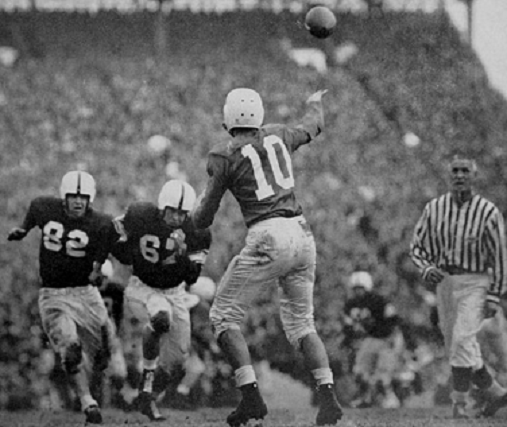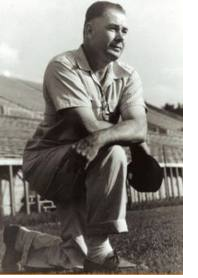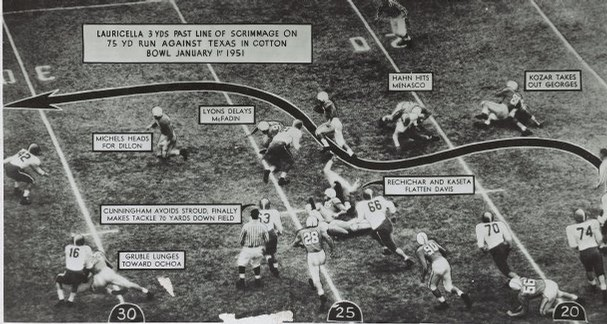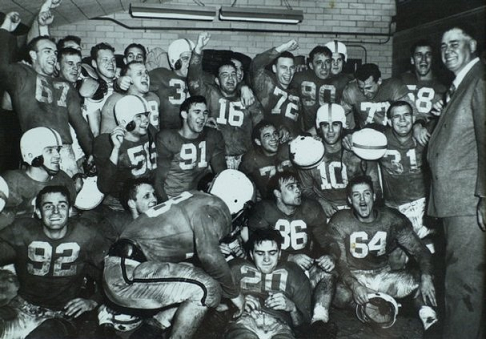


| North Texas (7-2-1) | 25-0 | |
| Louisiana State (4-5-2) | 14-0 | |
| Mississippi (5-5) | 27-0 | |
| Dayton (4-6) | 40-0 | |
| Cincinnati (8-4) | 41-7 | |
| at Villanova (4-5) | 34-7 | |
| at Georgia Tech (5-6) | 28-14 | |
| Florida (5-5) | 40-6 | |
| at Mississippi State (4-5) | 48-21 | |
| North Dakota (5-2-2) | 83-0 | |
| at Tennessee (11-1) | 0-7 | #1 |
| Sugar Bowl Oklahoma (10-1) | 13-7 | #3 |
| Boston College (0-9-1) | 28-0 | |
| Texas A&M (7-4) | 34-28 | |
| (Dallas) Texas (9-2) | 14-13 | #4 |
| Kansas State (1-9-1) | 58-0 | |
| at Iowa State (3-6-1) | 20-7 | |
| at Colorado (5-4-1) | 27-18 | |
| at Kansas (6-4) | 33-13 | |
| Missouri (4-5-1) | 41-7 | |
| Nebraska (6-2-1) | 49-35 | |
| at Oklahoma State (4-6-1) | 41-14 | |
| Sugar Bowl Kentucky (11-1) | 7-13 | #2 |
| Williams (7-1) | 66-0 | |
| Rutgers (4-4) | 34-28 | |
| Navy (3-6) | 20-14 | |
| at Brown (1-8) | 34-0 | |
| Cornell (7-2) | 27-0 | #17 |
| Colgate (5-3) | 45-7 | |
| Harvard (1-7) | 63-26 | |
| at Yale (6-3) | 47-12 | |
| Dartmouth (3-5-1) | 13-7 |
| Colgate (5-3) | 28-0 | |
| Penn State (5-3-1) | 41-7 | |
| Michigan (6-3-1) | 27-6 | #8 |
| at Harvard (1-7) | 49-0 | |
| at Columbia (4-5) | 34-0 | |
| at Penn (6-3) | 28-13 | #18 |
| New Mexico (2-8) | 51-0 | |
| at Stanford (5-3-2) | 7-0 | #22 |
| (Philadelphia) Navy (3-6) | 2-14 |
| Oregon State (3-6) | 38-13 | |
| at Michigan (6-3-1) | 14-7 | #8 |
| Maryland (7-2-1) | 7-34 | |
| William & Mary (4-7) | 33-14 | |
| Marquette (5-3-1) | 34-6 | |
| at Notre Dame (4-4-1) | 36-33 | |
| Indiana (3-5-1) | 35-0 | |
| Minnesota (1-7-1) | 27-0 | |
| at Pittsburgh (1-8) | 19-0 |
| Montana State (1-8) | 61-13 | |
| Baylor (7-3) | 7-0 | (#26) |
| Colorado State (6-3) | 34-0 | |
| at Utah State (2-9) | 40-7 | |
| at Utah (3-4-3) | 53-13 | |
| New Mexico (2-8) | 44-0 | |
| at Idaho (3-5-1) | 14-7 | |
| at Brigham Young (4-5-1) | 48-0 | |
| at Denver (3-8-1) | 42-12 | |
| Gator Bowl Washington & Lee (8-3) | 20-7 | #24 |
| Presbyterian (5-5) | 55-0 | |
| at Missouri (4-5-1) | 34-0 | |
| North Carolina State (5-4-1) | 27-0 | |
| at South Carolina (3-4-2) | 14-14 | |
| at Wake Forest (6-1-2) | 13-12 | |
| Duquesne (2-6-1) | 53-20 | |
| at Boston College (0-9-1) | 35-14 | |
| Furman (2-8-1) | 57-2 | |
| at Auburn (0-10) | 41-0 | |
| Orange Bowl Miami-Florida (9-1-1) | 15-14 | #15 |

| Southern Miss (5-5) | 56-0 | |
| at Mississippi State (4-5) | 0-7 | |
| at Duke (7-3) | 28-7 | |
| Tennessee-Chattanooga (1-9) | 41-0 | |
| Alabama (9-2) | 14-9 | #16 |
| Washington & Lee (8-3) | 27-20 | #24 |
| North Carolina (3-5-2) | 16-0 | |
| Tennessee Tech (4-7) | 48-14 | |
| Mississippi (5-5) | 35-0 | |
| Kentucky (11-1) | 7-0 | #2 |
| at Vanderbilt (7-4) | 43-0 | |
| Cotton Bowl Texas (9-2) | 20-14 | #4 |
 Tennessee had previously split the 1938 MNC with Texas Christian. The coach then was still the coach in 1950, Hall of Famer Bob Neyland (pictured at left). He had played at end for Army's 1914
MNC team, and he coached at Tennessee in 3
stints, 1926-1934, 1936-1940, and 1946-1952, going 173-31-12. That
places him in the top 10 for all-time FBS coaching win percentage. He won 2
Southern Conference and 5 SEC titles, and the school claims 4 MNCs
during his time, though only 2 are legitimate in my view:
1938 and this season. In the other two, 1940 and 1951, Tennessee
had a perfect regular season spoiled by a bowl loss. Neyland only once
completed a
perfect season, 11-0 in 1938, though his teams finished 11 other
seasons with exactly 1 loss or tie. Tennessee's stadium was designed by
and is named for him.
Tennessee had previously split the 1938 MNC with Texas Christian. The coach then was still the coach in 1950, Hall of Famer Bob Neyland (pictured at left). He had played at end for Army's 1914
MNC team, and he coached at Tennessee in 3
stints, 1926-1934, 1936-1940, and 1946-1952, going 173-31-12. That
places him in the top 10 for all-time FBS coaching win percentage. He won 2
Southern Conference and 5 SEC titles, and the school claims 4 MNCs
during his time, though only 2 are legitimate in my view:
1938 and this season. In the other two, 1940 and 1951, Tennessee
had a perfect regular season spoiled by a bowl loss. Neyland only once
completed a
perfect season, 11-0 in 1938, though his teams finished 11 other
seasons with exactly 1 loss or tie. Tennessee's stadium was designed by
and is named for him.

| 1) DeVold
(math system) |
4.93 |
| 2)
College
Football Researchers Association Billingsley (math) | 4.89 |
| 4) National Championship Foundation | 4.76 |
| 5) Boand (math) | 4.67 |
| 6) Poling
(math) |
4.62 |
| 7) AP Poll | 4.61 |
| 8) Houlgate (math) | 4.53 |
| 9) Dunkel (math) | 4.41 |
| 10) Litkenhous (math) | 4.38 |
| 11) Sagarin-ELO (math) | 4.29 |
| 12) Sagarin (math) | 4.05 |
| 13) Helms Foundation | 4.03 |
| 14) Berryman (math) | 4.02 |
| 15) Williamson (math) | 3.56 |
| 1) Boand (math system) | 4.26 |
| 2) College Football Researchers Association | 4.22 |
| 3) Poling (math) | 4.11 |
| 4) Helms | 4.09 |
| 5) Sagarin-ELO (math) | 4.06 |
| 6) National Championship Foundation | 3.96 |
| 7) Dickinson (math) | 3.49 |
| 8) Houlgate (math) | 3.35 |
| 9) Billingsley (math) | 3.34 |
| 10) Sagarin (math) | 3.28 |
| 11) Parke Davis | 2.77 |
| 1) Houlgate (math system) | 4.5 |
| 2) Helms | 4.3 |
| 3) Parke Davis | 4.2 |
| 4) National Championship Foundation | 3.7 |
| 5) Billingsley (math) | 3.6 |